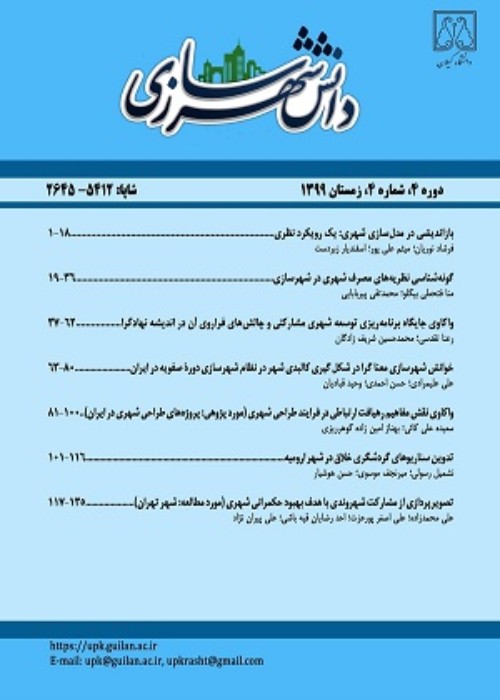Developing a model to evaluate the publicness of urban spaces
Author(s):
Article Type:
Research/Original Article (دارای رتبه معتبر)
Abstract:
As one of the prominent elements in urban structures, urban public spaces include squares, streets, plazas, parks, etc. These spaces have been always important for urban design and their quality of publicness has been discussed. The recent inclination towards semi-public spaces has led to the decline of these spaces’ publicness and function and has dragged them down from their previous position which has resulted in the emergence of spaces with unfavorable publicness quality. The present study seeks to explore the concept of publicness and models used to evaluate it, present a conceptual framework, and eventually propose a model for the evaluation of urban spaces’ publicness.To compile the conceptual framework, evaluation models proposed by domestic and international scholars were studied and the proposed model for evaluating the publicness of urban spaces was thus developed consisting of four components, seven sub-components, and 30 indicators. 12 urban experts and professionals were asked for their opinions using the hierarchical analysis method to assess the validity and assign weights to the model. Then the scores were normalized for better and more accurate comparison and the mean scores of the expert group were calculated for each component, sub-component, and indicators in a range between 0 to 1.Results of experts' weighting and determination of the final coefficients of each indicator led to the compilation of the final model for urban space publicness evaluation with four components, seven sub-components, and 26 indicators. Two components of “physical configuration” and “urban life” are related to the substantial dimension of urban design but the other two components of “ownership” and “management” are related to the procedural dimension of urban design. Three indicators of the “physical configuration” component consisting of “furniture flexibility”, “green-blue elements”, “bicycle facilities”, and CCTV indicator of “management” component were excluded. Hence, the four components of physical configuration (0.33), urban life (0.31), management (0.2), and ownership (0.16) make up the publicness of urban spaces. This model can be used as a tool alongside other conventional methods to evaluate the publicness of urban spaces from the perspective of designers and users' lived experiences.
Keywords:
Language:
Persian
Published:
Urban Planning Knowledge, Volume:6 Issue: 3, 2022
Pages:
67 to 84
magiran.com/p2545173
دانلود و مطالعه متن این مقاله با یکی از روشهای زیر امکان پذیر است:
اشتراک شخصی
با عضویت و پرداخت آنلاین حق اشتراک یکساله به مبلغ 1,390,000ريال میتوانید 70 عنوان مطلب دانلود کنید!
اشتراک سازمانی
به کتابخانه دانشگاه یا محل کار خود پیشنهاد کنید تا اشتراک سازمانی این پایگاه را برای دسترسی نامحدود همه کاربران به متن مطالب تهیه نمایند!
توجه!
- حق عضویت دریافتی صرف حمایت از نشریات عضو و نگهداری، تکمیل و توسعه مگیران میشود.
- پرداخت حق اشتراک و دانلود مقالات اجازه بازنشر آن در سایر رسانههای چاپی و دیجیتال را به کاربر نمیدهد.
In order to view content subscription is required
Personal subscription
Subscribe magiran.com for 70 € euros via PayPal and download 70 articles during a year.
Organization subscription
Please contact us to subscribe your university or library for unlimited access!


